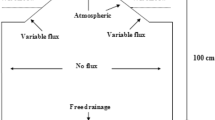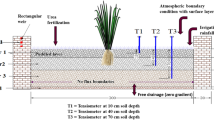Abstract
Simulation of nitrogen (N) uptake during crop growing season is very practical in improving fertilizer management and environmental protection. It is very valuable to have a tool which can perform this simulation in a reliable way. HYDRUS-2D model has widely been used to predict the water flow and fate of nutrients in soil. However, no specific research has been conducted so far to evaluate this model in simulating uptake of different N forms (i.e., nitrate and ammonium) during crop growing season. The objectives of this study were to simulate N uptake and transport under furrows and ridges during the maize growth period using HYDRUS-2D model under different N stresses. Thus, maize was planted with different application rates of urea including 0, 150 and 250 kg N ha−1 over 2015 and 2016 growing seasons. Data from the first and second seasons were applied to calibrate and validate model parameters, respectively. The N uptake, soil water content and nitrate and ammonium concentrations in different depths under furrows and ridges were measured during both seasons. Results indicated appropriate agreement between predicted and measured water content, nitrate and ammonium distribution in soil during the validation stage. The ranges of the normalized root mean square error (NRMSE) for nitrate and ammonium concentrations in soil for all treatments were about 22.28 to 23.36% and 17.06 to 24.79% that implies a fair accuracy of HYDRUS-2D model. In spite of appropriate accuracy in estimating total N uptake at harvest time, the model was not capable to simulate accumulated N uptake with high accuracy (13.82 ≤ NRMSE ≤ 29.53) during the growth periods. Consequently, ignoring some processes such as the active uptake to simplify the simulation caused the model to underestimate N uptake rate during the vegetative stage when the maize reaches its maximum growth rate. In addition, the N uptake was simulated more accurately in the absence of N stress.







Similar content being viewed by others
References
Abbasi F, Šimůnek J, Feyen J, van Genuchten MT, Shouse PJ (2003a) Simultaneous inverse estimation of soil hydraulic and solute transport parameters from transient field experiments: homogeneous soil. Trans ASAE 46(4):1085–1095
Abbasi F, Jacques D, Šimůnek J, Feyen J, van Genuchten MT (2003b) Inverse estimation of the soil hydraulic and solute transport parameters from transient field experiments: heterogeneous soil. Trans ASAE 46(4):1097–1111
Abbasi F, Feyen J, Van Genuchten MT (2004) Two-dimensional simulation of water flow and solute transport below furrows: model calibration and validation. J Hydrol 290(1–2):63–79
Allen RG, Pereira LS, Raes D, Smith M (1998) Crop Evapotranspiration-Guidelines for computing crop water requirements-FAO Irrigation and drainage paper 56. FAO, Rome, 300(9), D05109
Blair GJ, Miller MH, Mitchell WA (1970) Nitrate and Ammonium as Sources of Nitrogen for Corn and Their Influence on the Uptake of Other Ions 1. Agron J 62(4):530–532
Bremner JM, Keeney DR (1965) Steam distillation methods for determination of ammonium, nitrate and nitrite. Anal Chim Acta 32:485–495
Crevoisier D, Popova Z, Mailhol JC, Ruelle P (2008) Assessment and simulation of water and nitrogen transfer under furrow irrigation. Agric Water Manag 95(4):354–366
Ebrahimian H, Liaghat A, Parsinejad M, Abbasi F, Navabian M (2012) Comparison of one- and two dimensional models to simulate alternate and conventional furrow fertigation. J Irrig Drain Eng 138(10):929–938
Ebrahimian H, Liaghat A, Parsinejad M, Playan E, Abbasi F, Navabian M (2013) Simulation of 1D surface and 2D subsurface water flow and nitrate transport in alternate and conventional furrow fertigation. Irrig Sci 31(3):301–316
Fang Q, Yu Q, Wang E, Chen Y, Zhang G, Wang J, Li L (2006) Soil nitrate accumulation, leaching and crop nitrogen use as influenced by fertilization and irrigation in an intensive wheat–maize double cropping system in the North China Plain. Plant Soil 284(1–2):335–350
Feddes RA, Kowalik PJ, Zaradny H (1978) Simulation of field water use and crop yield. Wiley, New York
Gheysari M, Mirlatifi SM, Bannayan M, Homaee M, Hoogenboom G (2009) Interaction of water and nitrogen on maize grown for silage. Agric Water Manag 96(5):809–821
Hanson BR, Šimůnek J, Hopmans JW (2006) Evaluation of urea–ammonium–nitrate fertigation with drip irrigation using numericalmodeling. Agric Water Manag 86(1–2):102–113
Horowitz W (1970) Official methods of analysis of the association of official analytical chemists, 11th edn. Association of Official Analytical Chemists, Washington, DC
Jamieson PD, Porter JR, Wilson DR (1991) A test of the computer simulation model ARC-WHEAT1 on wheat crops grown in New Zealand. Field Crops Res 27:337–350
Klute A (1986) Water retention: laboratory methods. In: Klute A (ed) Methods of soil analysis. Part I: physical and mineralogical methods. ASA and SSSA, Madison, pp 635–662
Lemaire G, Gastal F (2008) Quantifying responses of crop species to N nutrition deficiency: improving N use efficiency. In: Sadras VO, Calderini DF (eds) Crop physiology: applications for genetic improvement and agronomy. Academic Press, San Diego, pp 171–211
Li WJ, Xia YQ, Ti CP, Yan XY (2011) Evaluation of biological and chemical nitro-gen indices for predicting nitrogen-supplying capacity of paddy soils in the Taihu Lake region, China. Biol Fertil Soils 47:669–678
Li Y, Šimůnek J, Zhang Z, Jing L, Ni L (2015) Evaluation of nitrogen balance in a direct-seeded-rice field experiment using Hydrus-1D. Agric Water Manag 148:213–222
Mailhol JC, Crevoisier D, Triki K (2007) Impact of water application conditions on nitrogen leaching under furrow irrigation: experimental and modeling approaches. Agric Water Manag 87(3):275–284
Mualem Y (1976) A new model for predicting the hydraulic conductivity of unsaturated porous media. Water Resour Res 12(3):513–522
Nakasone H, Abbas MA, Kuroda H (2004) Nitrogen transport and transformation in packed soil columns from paddy fields. Paddy Water Environ 2(3):115–124
Nkrumah M, Griffith S, Ahmad N (1989) Lysimeter and field studies on 15N in a tropical soil: II. Transformation of (NH2)2CO-15N in a tropical loam in lysimeter and field plots. Plant Soil 114(1):13–18
Phogat V, Mahadevan M, Skewes M, Cox JW (2012) Modelling soil water and salt dynamics under pulsed and continuous surface drip irrigation of almond and implications of system design. Irrig Sci 30(4):315–333
Plénet D, Lemaire G (1999) Relationships between dynamics of nitrogen uptake and dry matter accumulation in maize crops determination of critical N concentration. Plant and Soil 216(1–2):65–82
Richards LA (1954) Diagnosis and improvement of saline and alkali soils (Agriculture Handbook No. 60). US Department of Agriculture, Washington DC
Robbins CW, Carter DL (1980) Nitrate-nitrogen leached below the root zone during and following alfalfa. J Environ Qual 9(3):447–450
Schortemeyer M, Feil B, Stamp P (1993) Root morphology and nitrogen uptake of maize simultaneously supplied with ammonium and nitrate in a split-root system. Ann Bot 72(2):107–115
Sepaskhah AR (2010) Organic agriculture and water and fertilizer productivities. Conference of Organic Agriculture, Academy of Sciences, Tehran (in Persian)
Sepaskhah AR, Hosseini SN (2008) Effects of alternate furrow irrigation and nitrogen application rates on yield and water- and nitrogen-use efficiency of winter wheat (Triticum aestivum L.). Plant Prod Sci 11(2):250–259
Šimůnek J, Hopmans JW (2009) Modeling compensated root water and nutrient uptake. Ecol Modell J 220:505–521
Šimůnek J, Kodesova R, Gribb MM, van Genuchten MT (1999) Estimating hysteresis in the soil water retention function from cone permeameter experiments. Water Resour Res 35(5):1329–1345
Šimůnek J, Van Genuchten MT, Šejna M (2006) The HYDRUS software package for simulating two-and three-dimensional movement of water, heat, and multiple solutes in variably-saturated media. Techn Manual Ver 1:241
Šimůnek J, Van Genuchten MT, Sejna M (2008) Development and applications of the HYDRUS and STANMOD software packages, and related codes. Vadose Zone J 7(2):587–600
Šimůnek J, Bristow KL, Helalia SA, Siyal AA (2016) The effect of different fertigation strategies and furrow surface treatments on plant water and nitrogen use. Irrig Sci 34(1):53–69
Siyal AA, Bristow KL, Šimůnek J (2012) Minimizing nitrogen leaching from furrow irrigation through novel fertilizer placement and soil surface management strategies. Agric Water Manag 115:242–251
Ta CT, Weiland RT (1992) Nitrogen partitioning in maize during ear development. Crop Sci 32(2):443–451
Tafteh A, Sepaskhah AR (2012) Application of HYDRUS-1D model for simulating water and nitrate leaching from continuous and alternate furrow irrigated rapeseed and maize fields. Agric Water Manag 113:19–29
Tiercelin JR, Vidal A (2006) Treaty of Irrigation, 2nd edn. Lavoisier, Technique and Documentation, Paris
Van Genuchten MT (1980) A closed form equation for predicting the hydraulic conductivity of unsaturated soils. Soil Sci Soc Am J 44:892–898
Wesseling JG, Elbers JA, Kabat P, van den Broek BJ (1991) SWATRE: instructions for input. Internal Note, Winand Staring Centre, Wageningen, The Netherlands. International Waterlogging and Salinity Research Institute, Lahore, Pakistan
Wöhling T, Mailhol JC (2007) A physically based coupled model for simulating 1D surface—2D subsurface flow and plant water uptake in irrigation furrows. II: model test and evaluation. J Irrig Drain Eng 133(6):548–558
Wöhling T, Schmitz GH (2007) A physically based coupled model for simulating 1D surface—2D subsurface flow and plant water uptake in irrigation furrows. I: model development. J Irrig Drain Eng 133(6):538–547
Wylie BK, Shaffer MJ, Brodahl MK, Dubois D, Wagner DG (1994) Predicting spatial distributions of nitrate leaching in northeastern Colorado. J Soil Water Conserv 49:288–293
Yin F, Fu B, Mao R (2007) Effect of nitrogen fertilizer application rates on nitrate nitrogen distribution in saline soil in the Hai river basin, china. J Soils Sediments 7(3):136–142
Zerihun D, Sanchez CA, Lazarovitch N, Warrick AW, Clemmens AJ, Bautista E (2014) Modeling flow and solute transport in irrigation furrows. Irrig Drain Syst Eng 3(2):16
Zhang X, Wang Q, Xu J, Gilliam FS, Tremblay N, Li C (2015) In situ nitrogen mineralization, nitrification, and ammonia volatilization in maize field fertilized with urea in Huanghuaihai Region of Northern China. PLoS One 10(1):1–15
Zhou JB, Xl JG, Chen ZJ, Li SX (2006) Leaching and transformation of nitrogen fertilizer in soil after application of N with irrigation: a soil column method. Pedosphere J 6(2):245–252
Author information
Authors and Affiliations
Corresponding author
Additional information
Communicated by Y. Li.
Publisher's Note
Springer Nature remains neutral with regard to jurisdictional claims in published maps and institutional affiliations.
Rights and permissions
About this article
Cite this article
Ranjbar, A., Rahimikhoob, A., Ebrahimian, H. et al. Simulation of nitrogen uptake and distribution under furrows and ridges during the maize growth period using HYDRUS-2D. Irrig Sci 37, 495–509 (2019). https://doi.org/10.1007/s00271-019-00627-5
Received:
Accepted:
Published:
Issue Date:
DOI: https://doi.org/10.1007/s00271-019-00627-5




